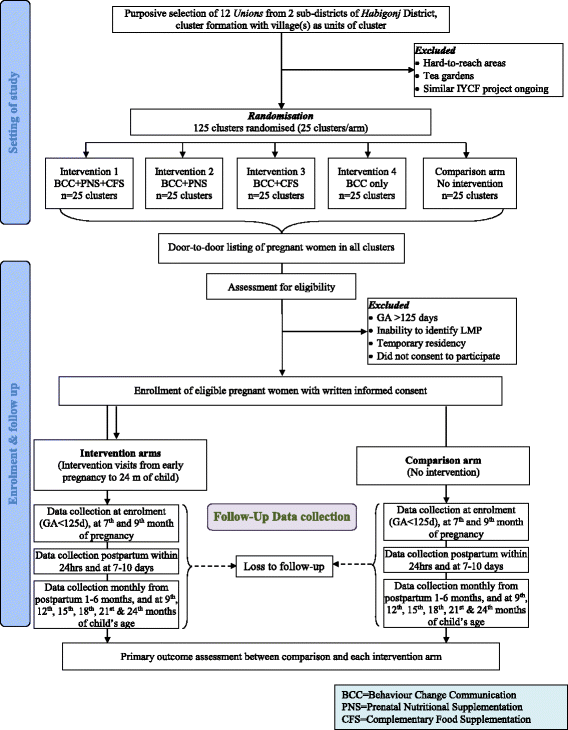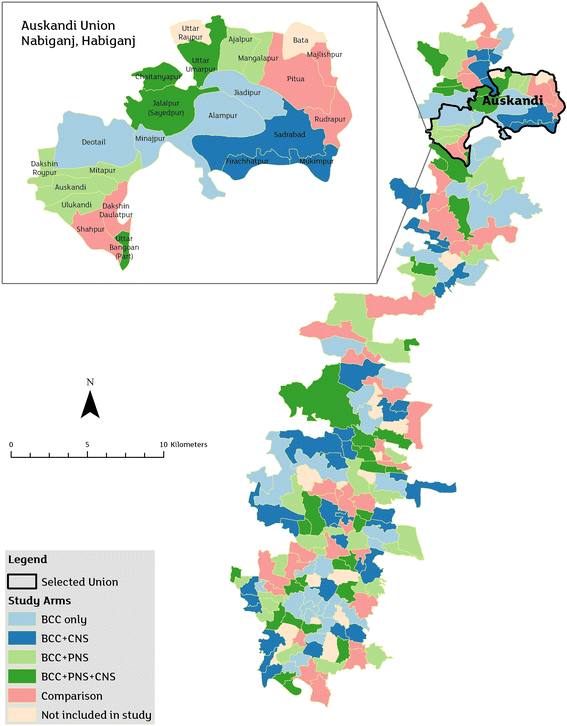A community-based cluster randomised controlled trial to evaluate the effectiveness of different bundles of nutrition-specific interventions in improving mean length-for-age z score among children at 24 months of age in rural Bangladesh: study protocol
- PMID: 28464867
- PMCID: PMC5414300
- DOI: 10.1186/s12889-017-4281-0
A community-based cluster randomised controlled trial to evaluate the effectiveness of different bundles of nutrition-specific interventions in improving mean length-for-age z score among children at 24 months of age in rural Bangladesh: study protocol
Abstract
Background: Prevalence of stunting among under-five children in Bangladesh is 36%, varying with geographic and socio-economic characteristics. Previously, research groups statistically modelled the effect of 10 individual nutrition-specific interventions targeting the critical first 1000 days of life from conception, on lives saved and costs incurred in countries with the highest burden of stunted children. However, primary research on the combined effects of these interventions is limited. Our study directly addresses this gap by examining the effect of combinations of 5 preventive interventions on length-for-age z-scores (LAZ) among 2-years old children.
Methods: This community-based cluster randomised trial (c-RCT) compares 4 intervention combinations against one comparison arm. Intervention combinations are: 1) Behaviour change communication (BCC) on maternal nutrition during pregnancy, exclusive breastfeeding, and complementary feeding, along with prenatal nutritional supplement (PNS) and complementary food supplement (CFS); 2) BCC with PNS; 3) BCC with CFS; and 4) BCC alone. The comparison arm receives only routine health and nutrition services. From a rural district, 125 clusters were selected and randomly assigned to any one of the five study arms by block randomisation. A bespoke automated tab-based system was developed linking data collection, intervention delivery and project supervision. Total sample size is 1500 pregnant women, with minimum 1050 resultant children expected to be retained, powered to detect a difference of at least 0.4 in the mean LAZ score of children at 24 months, the main outcome variable, between the comparison arm and each intervention arm. Length and other anthropometric measurements, nutritional intake and other relevant data on mother and children are being collected during enrolment, twice during pregnancy, postpartum monthly till 6 months, and every third month thereafter till 24 months.
Discussion: This c-RCT explores the effectiveness of bundles of preventive nutrition intervention approaches addressing the critical window of opportunity to mitigate childhood stunting. The results will provide robust evidence as to which bundle(s) can have significant effect on linear growth of children. Our study also will have policy-level implications for prioritising intervention(s) tackling stunting.
Trial registration: The study was retrospectively registered on May 2, 2016 and is available online at ClinicalTrials.gov (ID: NCT02768181 ).
Keywords: Bundling; First 1000 days of life; Length-for-age; Nutrition interventions; Randomised controlled trial; Stunting.
Figures
References
-
- Levels and Trends in Child Malnutrition: UNICEF/WHO/The World Bank joint child malnutrition estimates [Internet]. UNICEF, WHO and The World Bank. 2014. http://www.who.int/nutgrowthdb/summary_jme_2013.pdf. Accessed 6 Sept 2016.
-
- UNICEF. Improving child nutrition: The achievable imperative for global progress. 2013. Report No.: Contract No.
-
- Martorell R, Horta BL, Adair LS, Stein AD, Richter L, Fall CH, Bhargava SK, Biswas SK, Perez L, Barros FC, et al. Weight gain in the first two years of life is an important predictor of schooling outcomes in pooled analyses from five birth cohorts from low- and middle-income countries. J Nutr. 2010;140(2):348–354. doi: 10.3945/jn.109.112300. - DOI - PMC - PubMed
-
- Martorell R, Khan LK, Schroeder DG. Reversibility of stunting: epidemiological findings in children from developing countries. Eur J Clin Nutr. 1994;48(Suppl 1):S45–S57. - PubMed
Publication types
MeSH terms
Associated data
LinkOut - more resources
Full Text Sources
Other Literature Sources
Medical
Miscellaneous



